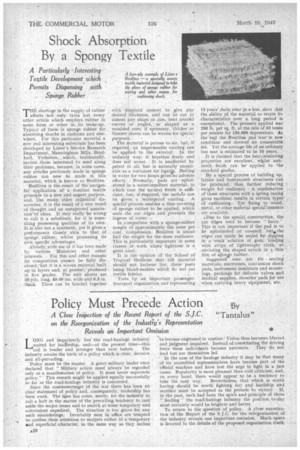Shock Absorption By a Spongy Textile
Page 20

If you've noticed an error in this article please click here to report it so we can fix it.
A Particularly Interesting Textile Development which Permits Dispensing with Sponge Rubber
THE shortage in the supply of rubber affects -not only tyres but every other article which employs rubber in some form or other in. its make-up. Typical of these is sponge rubber for absorbing shocks in cushions and elsewhere. For this particular material a new and interesting substitute has been developed by Lister's Service Research Department, Manningham Mills, Bradford, Yorkshire, . which, incidentally., invites those interested to send along their problems, because, in some cases, any articles preAnously,xnade in sponge rubber can now be made in this material, which is known as Resilitex.
Resilitex is the result of the'successfulapplication of a• familiar textile principle to a new and u,rgent purpose, and, like many other industrial discoveries, it is the result Of a new trendof thought and an unexpected association''of ideas. It may really be wrong to call it a substitute, for it is something possessing qualities of its own. It is also not a synthetic, yet it gives:a. performance closely akin to that of. sponge rubber, whilst possessing its own specific' advantages.
• Already, wide use of it has been made by various -Ministries and other interests. For this 'and other reasons its composition cannot be fully disclosed,'but it is a woven material built up layers and, at present,produced. in five grades. The unit .sheets are 20 yds. long, 48-50 ins. Wide and 0.3 in. thick. These can be bonded together
with fireproof cement to give any desired thickness, -and can be cut to almost ny shape or size, bent around curves or angles, or shaped as a mould core; if necessary, thicker or thinner sheets can be woven for special purpose The require he app ordina does n . •
aterial is porous to air, bpt, if an impermeable coating can ied to the exterior. In the way, it breathes freely and t sweat. It is unaffected by petrol or oil, but is naturally unsuitable as a container for liquid. Boiling in water for two hours gives no adverse effects. Normally, pads are upholstered in .a water-repellent material, in -which case the natural -finish is sufficient, but, &required, the' surfate can be given a 'waterproof coating. A special process enables a thin covering of sponge rubber to be applied, which seals the cut edges andprevents the ingress of water. .
In comparison with a sponge-rubber sample of approximately the same per cent. compression, Resilitex is about half the weight for the same resilience. This is particularly important in some classes of work where lightness is a great asset.
It is the -opinion Of the School of Tropical Medicine that .tlib material' should not harbour lice, -these pests being blood-suckers which do not at textile fabrics.
' tests by an important passengertransport organization and representing
The require he app ordina does n
15 years' daily ;wear in a bus, .show that the ability of the material to retain its characteristics over a long period is exceptional. The pressure applied was 280 lb. per 8q. ft. at the rate of 63 beats per minute for 150,400 depressions. At the end the Resilitex pad 'was' in new condition and showed no measurable set. Yet the average life of an ordinary bus seat is estimated to be 10 years.
It is claimed that the heat-insulating properties are excellent, wbilst anti• moth finish can be applied to the standard grades.
• By a special process of building up: lattice and honeycomb structures can be produced, thus further reducing weight for resilience. A combination of these structures with a spring casing gives excellent reaults in certain types' of cushioning. For fixing to wood, metal, or other material special-cements are available.
.ibue to the special construction, the cut edges tend to become " hairy.' This is not important' if the pad is to be upholstei-ed or covered; but* the edges can• easily be sealed by dipping in a ';weak solution of gum, binding with strips of lightweight' cloth, or enclosing the shaped -article in a thin film of &lion, rubber. .— Suggested uses are for • seating materials, mattresses, concussion shock pads, instrument insulators and mountings, packings for delicate valves and Medical supplies, shoulder pads for use when carrying heavy equipment, etc.




















































